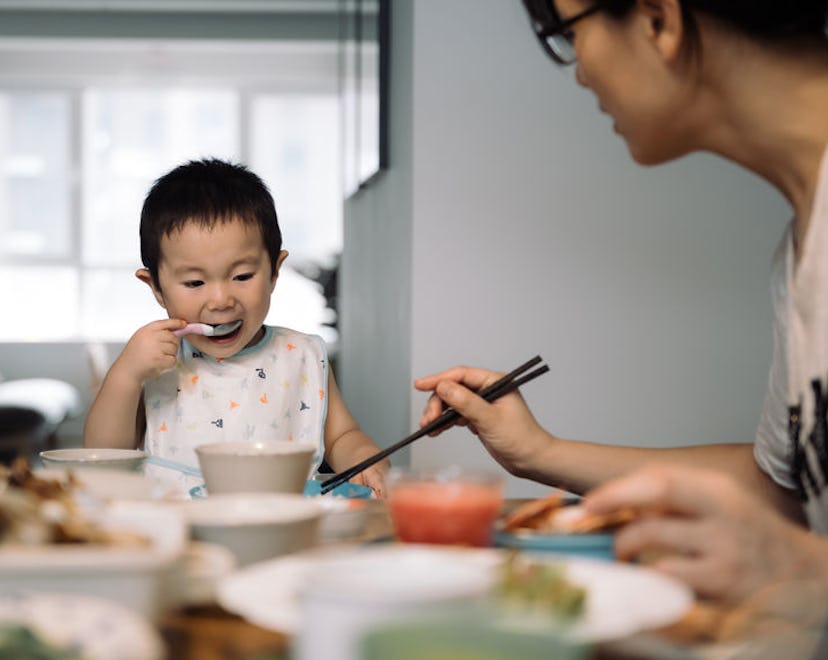Food

How To Introduce Toddlers To Shrimp & Identify If They’re Allergic
You’ve already got the grill ready.
One of the greatest joys of parenting is introducing your toddler to new foods. It opens up their world to fruit, veggies, pizza, and other iterations of melted cheese. As your toddler starts to try more foods, parents, especially those who prefer feeding their whole family the same dinner, may be wondering if toddlers can eat shrimp. The answer, in short, is yes, toddlers can eat shrimp, though there are still some things to be aware of.
While exciting, giving your child something they’ve never had before may bring up unexpected stress: Is this cut into small enough pieces? Will it end up enmeshed in the fibers of my carpet? What if my child has an allergic reaction? This fear can be especially prevalent when feeding your child food that is known to cause allergies, like shellfish.
Is it safe for toddlers to eat shrimp?
While your natural inclination is probably to scoop your child up and sprint in the opposite direction of anything, food or otherwise, that could cause harm, early introduction of new foods may be beneficial. “Early introduction of shellfish is a way to prevent food allergy. There is no reason to delay introduction,” Dr. Natasha Burgert, pediatrician at Pediatric Associates tells Romper. “Shrimp should be offered as a first food. There are minimal risks if the way the food is offered is developmentally safe.” This means it’s safe for toddlers and babies as young as 1 year old to try shrimp.
Serving sizes & nutritional value of shrimp for toddlers
It is safe to feed a child shrimp and other shellfish “as early as 4-6 months as long as the consistency is something a child can safely eat and swallow,” according to Dr. Purvi Parikh, allergist and immunologist with Allergy & Asthma Network. This means making sure the pieces are in very small, bite-sized pieces for toddlers (children ages 1-3) or blended for younger children. Pureed shrimp, basically a shrimp smoothie, probably does not sound particularly appetizing to you (nor to me if I’m being honest) but this is a safe way to expose them to new flavor and a dose of protein, antioxidants, selenium, and choline.
You know how much your toddler will eat, but generally, one ounce of shrimp (about two shrimp) is plenty for kids.
Signs of a shellfish allergy & what to do if you see signs of an allergic reaction to shrimp
A shellfish allergy is not the same as an allergy to fish, so even if your child has tried fish before, it’s a good idea to introduce shellfish separately. Whenever possible, avoid introducing too many foods at the same time because if an allergic reaction does occur, it’s hard to figure out what caused it.
If a parent is allergic to shrimp, it is more likely that their child will also be allergic. “Having a parent with any type of allergy increases risk [in their child] but we actually [still] recommend early introduction of the high risk foods to avoid it becoming an allergy,” says Parikh. While giving toddlers shellfish is largely considered safe, it's estimated by Food Allergy & Research nonprofit (FARE) that around 2% percent of the U.S. population is allergic to shellfish, and unfortunately, this type of allergy is not likely to be outgrown. So how do you know if your child is having an allergic reaction?
"Rash, itching swelling which may or may not be accompanied by vomiting, diarrhea, wheezing coughing, lethargy or loss of consciousness. The reactions usually occur within 30 minutes to an hour [after] eating a food,” Parikh tells Romper.
All allergic reactions in children, regardless of how mild they may seem, should be “evaluated by a physician because it’s hard to know [how it] will progress,” says Parikh. If your child is conscious and showing signs of a reaction, Burgert says to give Benadryl and call their doctor for next steps. In the case of a serious reaction, loss of consciousness, or constriction of the throat, call 911 immediately.
Shrimp is safe to introduce to toddlers and it’s a good source of protein, provides important nutrients, and is rich in omega-3s. As long as the shrimp is thoroughly cooked, cut into small pieces or pureed, and you keep a lookout for signs of an allergic reaction, feeding your toddler shrimp is a safe and healthy addition to their diet.
Experts:
Dr. Purvi Parikh, allergist and immunologist with Allergy & Asthma Network
Dr. Natasha Burgert, pediatrician at Pediatric Associates
This article was originally published on